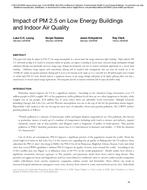Description
This paper will study the impact of PM 2.5 on energy consumption in a mixed mode low energy commercial office building. High ambient PM2.5, inherently needing to be treated to avoid poor indoor air quality, can impact a building in several ways: increased energy consumption throughadditional filtering and potentially increased energy usage through pressurization and loss in natural ventilation opportunity in a mixed modebuilding. Additional energy impacts with conventional filtering will be modeled with arrangements that can clean the outside air to theASHRAE indoor air quality standards. Beijing will be used as the location in the study as it is a city with over 20 million people and is knownto exhibit high PM 2.5 levels. Results indicate a significant increase in fan energy through utilization of the higher efficiency filters but only asmall increase in overall annual energy requirements. Pressurization and loss of natural ventilation will be topics for further study.
Citation: IAQ Conference: IAQ 2013: Environmental Health in Low Energy Buildings
Product Details
- Published:
- 2013
- Number of Pages:
- 7
- File Size:
- 1 file , 1.2 MB
- Product Code(s):
- D-2013IAQConf-12




